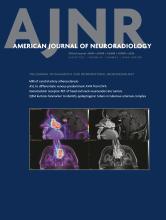Table of Contents
Perspectives
Review Article
- MR Imaging of Carotid Artery Atherosclerosis: Updated Evidence on High-Risk Plaque Features and Emerging Trends
MR imaging is the criterion standard for carotid artery plaque characterization and is best able to characterize features of plaque vulnerability: lipid-rich necrotic core, intraplaque hemorrhage, ulcerations, loss of fibrous integrity, maximum plaque thickness, and plaque enhancement. Many researchers believe that many embolic strokes of undetermined source may originate from nonstenotic ipsilateral carotid plaques with vulnerable features. From the results of many trials, many believe that imaging markers of plaque vulnerability should be considered in the determination of carotid endarterectomy eligibility.
Practice Perspectives
- Ecchordosis Physaliphora: Does It Even Exist?
Notochordal lesions span a spectrum of disease ranging from benign notochordal remnant (ecchordosis physaliphora) to low-grade to aggressively malignant. Benign notochordal remnant cannot be reliably distinguished from low-grade chordoma as they may have overlapping imaging features. Repeat imaging, beginning at 6-month intervals, is a more clinically relevant method for evaluating the malignant potential of these lesions.
General Contents
- Performance of Automated ASPECTS Software and Value as a Computer-Aided Detection Tool
This retrospective study compared the agreement of automated ASPECTS and raters with a different experience level in scoring patients with acute ischemic stroke with large-vessel occlusion undergoing thrombectomy. The agreement of all raters individually versus the criterion standard and interrater agreement improved with software assistance.
Commentary
- Reliable Initial Trauma CT Findings of Supraclavicular Brachial Plexus Injury in Patients Sustaining Blunt Injuries
A case (n = 36) - control (n = 50) study aimed to identify CT findings of supraclavicular brachial plexus injuries to discern who may require further evaluation with MR imaging. The results showed that scalene muscle edema/enlargement and interscalene fat pad effacement were most strongly associated with brachial plexus injury and demonstrated good sensitivity and specificity. These findings are best assessed with a soft-tissue reconstruction kernel; therefore, this should be incorporated as part of the trauma CT cervical spine assessment.
- Epileptogenic Tubers Are Associated with Increased Kurtosis of Susceptibility Values: A Combined Quantitative Susceptibility Mapping and Stereoelectroencephalography Pilot Study
Ten patients with tubers related to tuberous sclerosis complex underwent quantitative susceptibility mapping. The QSM and R2* distributions from tubers studied with stereoelectroencephalography demonstrated that increased kurtosis of quantitative susceptibility mapping values was highly specific and associated with epileptogenicity.
- Resisted Inspiration Improves Visualization of CSF-Venous Fistulas in Spontaneous Intracranial Hypotension
This retrospective cohort of patients with observed or suspected CSF-venous fistula identified during standard maximum suspended inspiration CT myelography were rescanned using resisted inspiration and the Valsalva maneuver. Visibility of the CSF-venous fistula was greatest during resisted inspiration in most of the cases.








